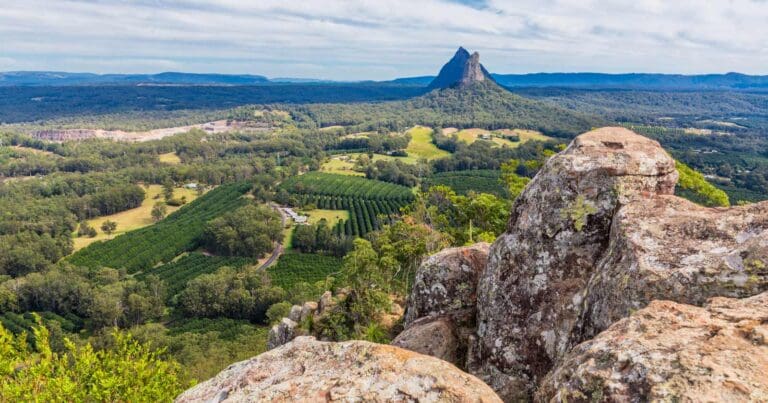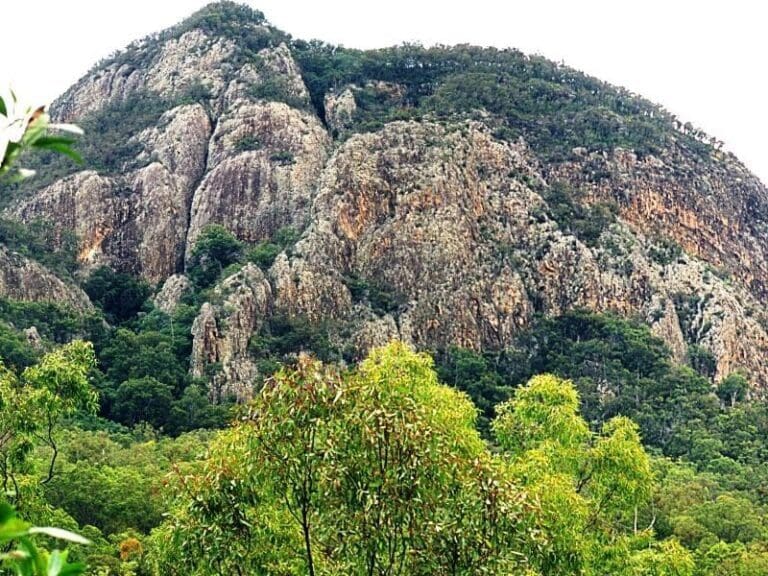Trail Fast Facts
Mount Beerwah Summit is a 4.3km, grade 5 hike in Glass House Mountains National Park, Queensland. This hike typically takes 1.5 hours to complete.
Warning
Summit routes are very challenging and only suitable for climbers or hikers with a high level of fitness, experience and skills in rock scrambling. This route includes steep, strenuous climbs with sheer rock faces. Rocks can be slippery and rockfalls can happen at any time. Summit routes are not walking tracks and are unsuitable for inexperienced people who cannot climb unassisted.
Hike Overview
Mount Beerwah (556m) is the highest of the Glass House Mountain peaks. This is a steep climb, requiring high fitness levels and some rock scrambling skills. The route takes you through wet eucalypt forest before opening up into heath, dotted with grass trees and banksias, as you climb towards the summit. At the summit you are rewarded with stunning 360 degree views of the coast, other Glass House peaks and the D'Aguilar Range to the west.
The Beerwah North Face Summit Track Route or "Hikers' Route" is the easiest and most popular access route. The summit route starts from the Mountain View lookout and continues for 300m up the western slope of the mountain. This first section of summit route has very loose and unstable rock until you reach the ‘No waiting zone’. The route then continues up a near vertical rockface to the summit—364m above sea level.
When deciding whether to climb the summit routes, consider respecting the Jinibara and Kabi Kabi peoples request to not climb the culturally-sacred Beerwah and Tibrogargan peaks.
Indigenous Lore of the Glass House Mountains
The Glass House Mountains hold deep spiritual significance for the Aboriginal people of the region, particularly the Jinibara and Kabi Kabi peoples. Their lore and customs are intricately woven with the landscape, and these mountains hold a place of immense importance.
One such example is Mount Beerwah. Considered the ancestral mother by the Jinibara people, respect for motherhood is a cornerstone of their culture. As such, they teach the importance of protecting Mount Beerwah and view climbing it as disrespectful to this sacred site.
The surrounding peaks hold significance as well. Tibrogargan is seen as the father figure, with Ngungun, his loyal dingo, by his side. The mountains themselves represent their children. This interconnection highlights the deep respect the Indigenous people have for the land and its formations.
In line with this rich Indigenous tradition, visitors are asked to refrain from climbing the Glass House Mountains. This act of respect preserves the cultural significance of these sacred places for future generations.
Track Grade
Grade 5 (Difficult) - Walks for the Most Experienced: Grade 5 represents the most challenging walking tracks on the AWTGS. These are only recommended for very experienced and fit walkers with specialised skills, including navigation and emergency first aid. Tracks are likely to be very rough, very steep, and unmarked. Walks may be more than 20 kilometers. These challenging walks demand a high level of fitness and experience to navigate difficult terrain, significant elevation changes, and potentially unformed paths.
Tips
- Summit routes are not walking tracks and are unsuitable for inexperienced people who cannot climb unassisted, bushwalkers and young children.
- Summit routes are suitable for people with a high level of fitness, experience and skills in rock scrambling. They have steep rocky sections and irregular surfaces with loose stones that require rock scrambling skills.
- People accessing the summit routes must be well-prepared climbers with a high level of fitness and rock-scrambling experience.
- The summit routes have exposed, steep rocky sections and irregular surfaces with loose stones that require rock scrambling and climbing skills.
- Serious injuries have occurred on summit routes, death may occur.
- Rock falls may occur at any time. If you access the summit routes you need to be aware of the risks. Your safety is your responsibility.
- Summit routes are not walking tracks and are unsuitable for inexperienced people who cannot climb unassisted and young children.
- If you feel unsure about your ability to climb or keep up with the rest of your group, then don't attempt it.
Map and GPX file
Max elevation: 441 m
Min elevation: 179 m
Total climbing: 336 m
Total descent: -336 m
Trailhead
Sorry, no records were found. Please adjust your search criteria and try again.
Sorry, unable to load the Maps API.
Getting there
To get to Mount Beerwah carpark from Glass House Mountains township by car:
The trailhead for the Mount Beerwah Summit Walk starts at the Mount Beerwah Carpark. If you're driving from Glass House Mountains town, the journey is easy. The total distance is only 9.1 kilometers and takes approximately 10 minutes by car.
From Brisbane, follow the Bruce Highway north, take the Glass House Mountains tourist drive turn-off and follow the signs to the Glass House Mountains.
The Glass House Mountains Visitor and Interpretive Centre is a great place to visit first for an orientation to the area. It is located at Settler's Rotary Park on Bruce Parade, corner of Reed Street, Glass House Mountains.
Within the national park, there are separate entrance points to each of the recreation nodes around the mountain peaks—Beerburrum, Beerwah, Ngungun and Tibrogargan entrances.
About the region
Explore the Glass House Mountains National Park: A Land of Dramatic Beauty and Rich History.
The Glass House Mountains National Park is a captivating landscape dominated by the craggy peaks that rise majestically from the surrounding plains. These volcanic plugs, formed millions of years ago, hold a significant place in Australian heritage and are listed on the Queensland and National Heritage Register.
Walking trails weave through open forests, leading you to lookouts boasting panoramic vistas of the mountains. Explore the base of Mount Tibrogargan for ever-changing perspectives, or conquer the summit of Mount Ngungun for breathtaking views of the surrounding peaks and landscapes.
For the adventurous, the Yul-yan-man track offers a challenging Grade 5 hike, perfect for experienced rock scramblers. Skilled climbers and abseilers will find other challenging routes and dedicated climbing areas to test their abilities.
Beyond the dramatic peaks, the park encompasses a scenic tapestry of pine plantations, bushland, and cultivated fields. Remnants of open eucalypt woodland and heath vegetation provide a habitat for diverse flora and fauna, including 20 plant species of high conservation value.
Lieutenant James Cook named these distinctive mountains during his voyage along Australia's east coast. Geologically, they are intrusive plugs formed by volcanic activity 26 to 27 million years ago.
The park holds deep cultural significance for the Aboriginal Traditional Owners. The Glass House Mountains served as a meeting place for ceremonies and trade, and many sacred sites are still protected within the park's boundaries.
Suggest an edit
Spotted a change on this trail? Maybe there are new features, the route has shifted, or the trail is permanently closed. Whatever the update, I’d love your input. Your feedback helps fellow hikers stay informed and ensures that our trail info stays fresh and reliable.
Similar trails nearby
Looking for things to do in Glass House Mountains National Park or nearby? Try these similar hikes or bushwalks.
Let someone know
Adventure with Confidence: Register Your Trip Plans
Before you hit the trail, take a moment to fill out our trip intentions form. It’s a simple way to share important details about your hike with family or friends. If things don’t go as planned and you’re not back on time, they can easily notify emergency services, helping to ensure a quick response and reducing worry. Enjoy your outdoor adventure knowing that you’ve taken a smart step for your safety.
Gear to consider
What you carry in your pack will depend on the weather, terrain, time of year, type of adventure, and personal preferences. Having trouble deciding what gear’s right for you? My free planning, food and packing checklists provide an introduction to things your could consider (as well as the Ten Essentials) on your day, overnight and multi-day adventures. Customise your kit according to your personal needs, always considering safety first.
Explore Safe
While planning your hike, it’s important to check official government sources for updated information, temporary closures and trail access requirements. Before hitting the trail, check local weather and bushfire advice for planned burns and bushfire warnings and let someone know before you go. Plan ahead and hike safely.
Weather
Acknowledgement of Country
Trail Hiking Australia acknowledges the Traditional Owners of the lands on which we hike and pay respects to their Elders, past and present, and we acknowledge the First Nations people of other communities who may be here today.







1 Review on “Mount Beerwah Summit Walk (4.3km)”
This well-worn trail offers a challenging, yet rewarding, hike. The initial section is particularly daunting – a steep climb with smooth rock surfaces that can make finding good footholds difficult. Proper footwear with good tread is crucial for safe navigation. Halfway up, you’ll come across a welcome flat section with interesting caves nestled into the cliff walls. Beyond this point, there’s another climb, but thankfully less strenuous than the first. The summit rewards you with panoramic views, making the effort worthwhile. For a more comfortable experience, consider tackling this climb early in the morning to avoid the harsh midday sun.